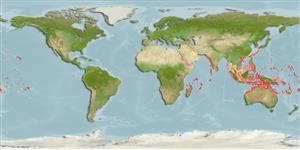Common names from other countries
Environment: milieu / climate zone / depth range / distribution range
Ecologia
marinhas associadas(os) a recifes; intervalo de profundidade 30 - 50 m (Ref. 1602). Tropical; 32°N - 24°S, 30°E - 145°W
Indo-Pacific: Red Sea to East Africa, through northern Australia to Society Islands, north to southern Japan.
Tamanho / Peso / Idade
Maturity: Lm ? range ? - ? cm
Max length : 55.0 cm TL macho/indeterminado; (Ref. 9770)
Espinhos dorsais (total) : 3; Raios dorsais (total) : 24 - 27; Espinhos anais: 0; Raios anais : 19 - 24. Dark brown, scales with yellow spot; pectoral, soft dorsal, anal and caudal fins dark with yellow margins; juveniles yellowish brown with bluish grey spots and blotches (Ref. 4420). Juveniles under about 5 cm, tan with dark saddles and numerous dark wavy lines on the body. Larger juveniles loose the dark saddles and become covered in a network of brilliant blue lines which become increasingly interconnected with growth (Ref. 37816).
Occur in clear shallow lagoons and seaward reefs; sandy areas near reef patches of reef edge are preferred. Adults on deep reefs or with shipwrecks, usually deeper than 30 meters. Juveniles inshore on rubble reef or small outcrops on open substrate (Ref. 48637). Feed on sea urchins, crustaceans, mollusks, dead fish, tunicates or corals (Ref. 5503). Oviparous (Ref. 205). Monogamous (Ref. 52884). Also caught with drive-in nets. Marketed fresh and dried-salted (Ref. 9770).
Ciclo de vida ou comportamento de acasalamento
Maturities | Reprodução | Spawnings | Egg(s) | Fecundities | Larvas
Distinct pairing (Ref. 205). Nest-guarding females are aggressive (Ref. 9770). Females are territorial, solely tending and guarding the eggs. Males exhibit polygyny (Ref. 116451).
Myers, R.F., 1991. Micronesian reef fishes. Second Ed. Coral Graphics, Barrigada, Guam. 298 p. (Ref. 1602)
Status na Lista Vermelha da UICN (Ref. 130435)
CITES (Ref. 128078)
Not Evaluated
Ameaça para os humanos
Harmless
Uso pelos humanos
Pescarias: espécies comerciais; Aquário: Espécies comerciais
Ferramentas
Relatórios especiais
Baixar XML
Fontes da internet
Estimates based on models
Preferred temperature (Ref.
115969): 24.7 - 28.4, mean 27.5 (based on 138 cells).
Índice de diversidade filogenética (Ref.
82804): PD
50 = 0.6250 [Uniqueness, from 0.5 = low to 2.0 = high].
Bayesian length-weight: a=0.03548 (0.02074 - 0.06071), b=2.94 (2.79 - 3.09), in cm Total Length, based on LWR estimates for this species & (Sub)family-body (Ref.
93245).
Nível Trófico (Ref.
69278): 4.0 ±0.0 se; based on diet studies.
Resiliência (Ref.
120179): médio(a), tempo mínimo de duplicação da população 1,4 - 4,4 anos (Preliminary K or Fecundity.).
Fishing Vulnerability (Ref.
59153): Moderate vulnerability (42 of 100).
